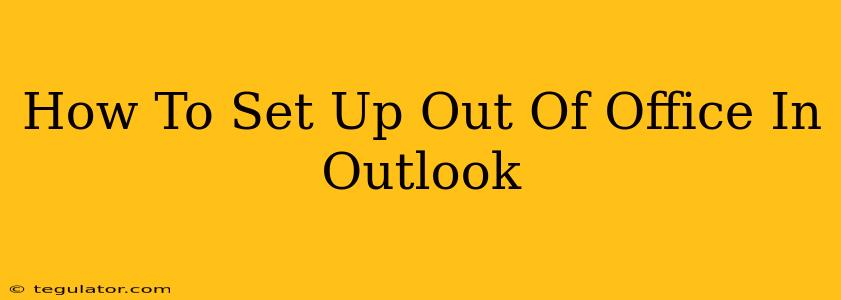Are you heading out for vacation, a business trip, or simply need some time away from your inbox? Setting up an automatic Out of Office reply in Outlook is essential to manage expectations and keep your senders informed. This comprehensive guide will walk you through setting up your Outlook Out of Office reply, whether you're using Outlook on the web, a desktop application, or a mobile device.
Setting Up Your Out of Office Reply in Outlook Desktop
This is the most common method, offering the most customization options.
Step 1: Accessing the Automatic Replies Settings
- Open your Outlook desktop application.
- Go to File > Automatic Replies (Out of Office).
Step 2: Choosing Your Reply Options
- Send automatic replies: Check this box to activate your Out of Office reply.
- Only send during this time range: (Optional) Set a specific start and end time for your automatic reply. This is great for controlling when the message is sent and received. Uncheck this option for continuous replies.
- Compose your message: This is where the magic happens. Craft a clear and concise message that informs your senders of your absence and provides relevant information. Here are some helpful elements to include:
Crafting the Perfect Out of Office Message
- Your unavailability: Clearly state the dates and times you'll be unavailable. For example: "I will be out of the office from October 26th to November 2nd."
- Reason for absence (optional): You can include a brief reason, but it's not always necessary. A simple "on vacation" or "attending a conference" suffices.
- Contact information (if applicable): If you have someone covering your work, provide their contact details. For urgent matters, consider providing an alternate contact person or department. For example: "For urgent matters, please contact John Smith at john.smith@email.com."
- Expected return: Let senders know when you expect to respond to their emails. Example: "I will respond to your email upon my return on November 3rd."
- Professional tone: Keep your message professional and avoid overly casual language.
Step 3: Inside and Outside Your Organization
Outlook allows you to send different messages to people inside and outside your organization. This is helpful if you want to be more specific with colleagues versus external clients.
- Send automatic replies only to people inside my organization: Choose this option to send a different message to colleagues within your company, allowing for internal communication during your absence.
- Send automatic replies to people outside my organization: This option lets you craft a different message for external contacts.
Step 4: Saving Your Settings
Once you've crafted your perfect Out of Office message, click OK. Your automatic replies are now active!
Setting Up Out of Office on Outlook on the Web (OWA)
The process for Outlook on the web is slightly different but equally straightforward.
Step 1: Accessing Automatic Replies
- Log into your Outlook account on the web.
- Click the Settings cog in the top right corner.
- Select View all Outlook settings.
- Navigate to Mail > Automatic replies.
Step 2: Enable Automatic Replies
- Turn on Automatic replies.
- Set your Start time and End time for the replies (optional).
- Compose your message for Inside my organization and Outside my organization, if needed, using the same best practices mentioned above for the desktop version.
Step 3: Save Your Settings
Save your settings, and your automatic reply will be active during the specified time.
Out of Office on Outlook Mobile App
The specific steps may vary slightly depending on your mobile operating system (iOS or Android), but the general process is similar. Usually, you'll find the Out of Office setting within your Settings menu within the Outlook mobile app. Look for options like "Automatic Replies" or "Out of Office." The app will generally guide you through the process of setting up your message and choosing a time frame.
Important Considerations
- Test your Out of Office reply: Send a test email to yourself to ensure it's working correctly.
- Turn off your Out of Office reply: Remember to turn off your automatic replies when you return to work to avoid confusion.
- Regularly review your settings: Ensure your settings are still relevant to your current needs.
By following these steps, you can easily set up an Out of Office reply in Outlook, ensuring seamless communication management during your absence. Remember to tailor your message to your specific needs and always maintain a professional tone.

